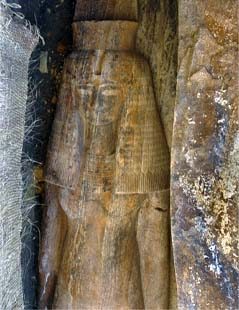Archaeologists uncover giant statue of ancient Egyptian queen
 Washington, April 1: Archaeologists have uncovered a giant statue of an ancient Egyptian queen at the mortuary temple of Amenhotep III on Luxor’s West Bank in Egypt.
Washington, April 1: Archaeologists have uncovered a giant statue of an ancient Egyptian queen at the mortuary temple of Amenhotep III on Luxor’s West Bank in Egypt.
According to a report in National Geographic News, a joint European-Egyptian team found the statue, which is 12-foot-tall, and attached to the broken-off leg of a much larger colossus of Amenhotep III, who ruled from about 1390 to 1350 B. C.
Experts have said that the newfound statue is of Queen Tiye, who was Amenhotep III’s favorite wife and the most influential woman of his 38-year reign, thus bolstering theories that female royalty were gaining in prominence and influence during the time period.
Because the temple complex was devastated by massive earthquakes in pharonic times and in the first century A. D., the discovery of an undamaged statue has surprised experts.
“The surprise was that she was not crushed,” said Hourig Sourouzian, who led the excavation and has been digging at the site since
2000.
“The leg of the larger colossus was very badly damaged, so the surprise was that the queen lying behind it was intact,”she added.
According to Sourouzian, “The first thing we saw of that statue was the thumb. But the block was getting larger and larger, and then we had the surprise of this beautiful queen who appeared there by the leg of the king.”
Queen Tiye was often depicted standing by the right leg of Amenhotep III colossi, and Amenhotep III's mother, Mutemwiya, was usually carved by his left leg.
The inscribed statue includes the titles “hereditary princess, great of honor, beloved of the lady of the sycamore, and mistress of the two lands.”
The newly discovered statue bolsters the theory that the period during Egypt’s 18th dynasty, which included Amenhotep III's rule, was a period of female empowerment, particularly among royalty.
“The statue shows that the women of the crown are so important they are represented openly on colossal scale,” said Sourouzian said, adding that one of Queen Tiye’s titles was the Great Royal Consort.
“This statue is tangible evidence of their growing importance. We know from other monuments and monuments of this sort that Queen Tiye shared power with her husband,” said Johnson from the Oriental institute.
Archaeologists also unearthed two sphinxes representing Amenhotep III and Queen Tiye and ten granite statues of the lioness goddess Sekhmet. (ANI)